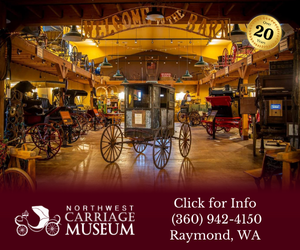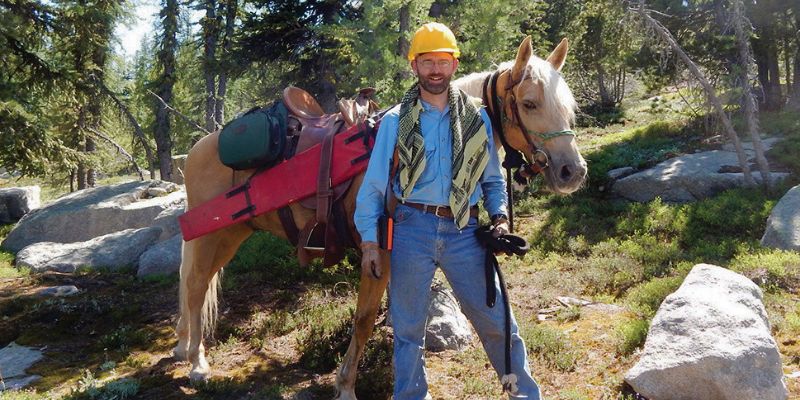A Tool for the Wilderness
You’ve seen the old lumberjack photographs—two men in plaid holding opposite ends of a huge, long saw steadily working on a tree trunk of colossal diameter. The tool these men used is the crosscut saw. Today you can find these vintage tools displayed as décor on the walls of your local Cracker Barrel restaurant or out on the trail. Thousands of trail workers still use these vintage crosscuts today, bucking and felling trees and clearing trails in the American outdoors. Often these classic tools are far older than the people wielding them. That’s certainly true in my case. I recently found a crosscut saw that my grandfather used long before I came into the picture. This summer that saw will be helping clear trails in the high country of the Pacific Northwest.
Vintage crosscuts are often the tool of choice for trail workers who maintain the country’s 806 wilderness areas. The reason this old tool has stuck around so long in an age when newer, “better” gadgets appear nearly every week goes beyond the saw itself. The rise, fall, and unexpected second life of the crosscut saw is tied to how America created the very concept of wilderness.
Congress passed the Wilderness Act in 1964. With that act America did something no other country had accomplished—it passed a law to protect and preserve land in its natural state. Because of how it defined wilderness, the act brought about some significant changes in land stewardship. Capital W wilderness was now designated as an area without mechanization and the presence of motors. Snowmobiles and bicycles aren’t allowed in federally designated wilderness areas. For the thousands of people who work and, more importantly, volunteer in wilderness areas today, this means they can’t use chainsaws. Crosscuts first made a comeback because they had to, but now they’re increasingly used even in non-wilderness areas where chainsaws are allowed.
Crosscut Advantages
There are many reasons for the comeback of this versatile and reliable tool that’s been used for centuries and is ideal for use in rugged environments. The primary advantage of a crosscut saw for wilderness areas is its low environmental impact. Unlike chainsaws, which require fuel and produce harmful exhaust fumes, a crosscut saw is powered by human energy alone, making it an eco-friendly option. This is particularly important in wilderness areas where minimizing human environmental impact is a top priority. The use of a crosscut saw ensures visitors can enjoy the natural beauty of the area without having to contend with the noise and pollution associated with modern power tools. A well-tuned crosscut, operated by an experienced sawyer, sings as it cuts through the wood grain and creates a harmony more at home in a wilderness setting than the cacophony of a chainsaw. In capable hands a crosscut saw is anything but a “misery whip.”
In addition, a crosscut saw is typically lighter and more portable than other types of saws. This makes it ideal for anyone who needs to carry their tools with them over long distances. A crosscut saw can be strapped to a pack saddle or stowed on a riding saddle without adding significant weight or taking up too much space.
Another advantage of a crosscut saw is its durability. A well-maintained crosscut saw can last for decades, making it a wise investment for anyone who spends time in the wilderness. In contrast, chainsaws tend to be fragile and require regular maintenance to keep them in good working order. Indeed, my newest crosscut has outlasted many chainsaws. New handles and a good sharpening will have it hewing logs in short order.
Finally, using a crosscut saw can be a rewarding and enjoyable experience. There is something deeply satisfying about using a simple tool to accomplish a challenging task in the great outdoors. The sound of the saw cutting through the wood, the smell of fresh sawdust, and the sense of accomplishment that comes from completing a task by hand can be immensely gratifying. For many people, using a crosscut saw is a way to reconnect with nature and rediscover the joys of manual labor.
Its low environmental impact, versatility, portability, safety, durability, and overall enjoyment make the crosscut saw a must-have for anyone who spends time in the great outdoors. Whether you’re building or clearing trails, a crosscut saw is an essential tool that will serve you well for years. The next time you venture into the woods, consider leaving the chainsaw behind and embracing the simplicity, beauty, and song of the crosscut saw.
As always, for more of my thoughts on trail riding, horse camping, and the world’s largest guide to horse trails and camps, visit us at www.TrailMeister.com or pick up a copy of my best-selling book The ABCs of Trail Riding and Horse Camping on Amazon.
See this article in the May/June 2023 online edition:
May/June 2023

Robert Eversole, ”the trail meister,” owns www.TrailMeister.com, the largest database of horse riding and camping areas in the U.S. with free trail and trailhead information, trail maps, and much more to help horse enthusiasts experience the joys of trail riding. Robert is a registered riding instructor with PATH International, a mounted search and rescue team member, and a U.S. Marine who has served on the board of the Backcountry Horsemen of Washington (BCHW). He is enjoying his new career helping fellow trail riders stay found and safe on the trail. When not on the trail, The Trail Meister resides near Spokane, WA and teaches land navigation to a wide variety of outdoor groups across the nation. For North America’s largest horse trail and camping directory, trail tips, and more, visit www.TrailMeister.com.






